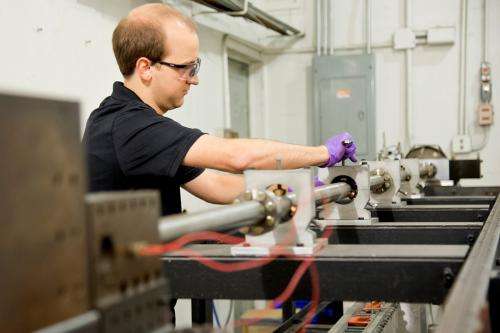Science is harnessing shock waves to create new materials

(Phys.org) —Researchers at Purdue University are part of a national effort to develop new materials having super strength and other properties by using shock waves similar to those generated by meteorites striking the Earth.
The research is funded by the National Nuclear Security Administration (NNSA) through a new center led by the University of Notre Dame and also includes collaborators from Indiana University. The Center for Shock Wave-processing of Advanced Reactive Materials (C-SWARM) is funded with $1.6 million annually for five years.
The center's primary mission is to predict shock conditions under which new materials can be synthesized.
A team of researchers at Purdue will perform experiments using equipment in the university's Maurice J. Zucrow Laboratories and the Robert L. and Terry L. Bowen Laboratory for Large-Scale Civil Engineering Research. The Purdue team is led by Steven Son, a professor of mechanical engineering, and Weinong Chen, a professor of aeronautics and astronautics and materials engineering and associate head for Graduate Education.
A meteorite impacting the Earth generates high pressures and temperatures. The researchers are striving to replicate these conditions to create materials able to withstand extreme temperatures and possessing superior strength and unique electromagnetic properties.
The Purdue researchers will work to validate and calibrate computational models for simulations of this "shock-induced synthesis." The models may enable the researchers to predict structures that could be produced through the synthesis.
Specifically, Purdue researchers plan to find a new approach for shock-induced synthesis of a material called cubic boron nitride, Son said.
The material has a crystal lattice structure similar to carbon's and could potentially exist in many forms.
"The hexagonal form corresponding to graphite is the most stable and softest among these forms and is used as a lubricant and an additive to cosmetic products," Son said. "The cubic variety is analogous to diamond, and its hardness is second only to diamond's, but its thermal and chemical stability is superior."
The cubic boron nitride is produced by treating hexagonal boron nitride at high pressure and temperature, much as synthetic diamond is produced from graphite. The material must be exposed to pressures at least 50 times greater than that at the bottom of Mariana Trench - about 11 kilometers below the ocean surface - and temperatures hotter than the melting point of iron.
The Purdue portion of the project also will involve a research scientist, a graduate student and an undergraduate student.
C-SWARM is one of six new centers of excellence whose primary focus is on the emerging field of predictive science.
Provided by Purdue University




















